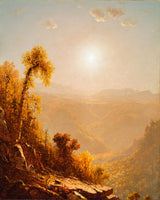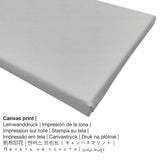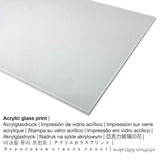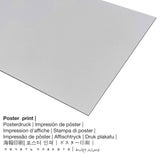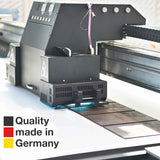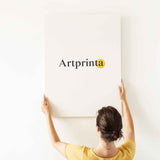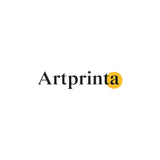Sanford Robinson Gifford, 1880 - October na Catskills - ọmarịcha nka
Ụtụ gụnyere. Mbupu gbakọrọ na ndenye ọpụpụ.
Product nkọwa
October in the Catskills is an artwork created by the romanticist American artist Sanford Robinson Gifford in 1880. A na-ese ihe osise ahụ na nha: 36 5/16 × 29 3/16 na (92,23 × 74,14 cm) ma were ihe osise ese Usoro of mmanụ na kwaaji. Besides, this artpiece is in the the digital collection of Ebe ngosi nka nke Los Angeles County. Site n'ikike nke - Ụlọ ihe ngosi nka nke Los Angeles County (www.lacma.org) (public domain).Furthermore, the artpiece has the creditline: . Moreover, alignment is in Eserese format and has an image ratio of 1 : 1.2, which means that the length is 20% shorter than the width. The painter Sanford Robinson Gifford was a North American artist from United States, whose artistic style can be attributed primarily to Romanticism. The North American painter was born in the year 1823 in Greenfield, Saratoga county, New York state, United States and passed away at the age of 57 na 1880 na New York City, New York steeti, United States.
Additional description from Los Angeles County Museum of Art (© Nwebiisinka - nke Los Angeles County Museum of Art - Ebe ngosi nka nke Los Angeles County)
In his address given at the memorial for Sanford Gifford, Worthington Whittredge said that no autumn came that Gifford did not visit his mother in the town of Hudson and the nearby Catskills. He loved the mountains and painted them more than any other subject. The motif of this painting is the Kaaterskill, or Kauterskill, Clove, a scenic gorge of the small Kaaterskill Creek that extends about five miles between Haines Falls village and Palenville. It was a theme for numerous Hudson River school artists, and Gifford sketched there as early as 1845 and exhibited a painting of the clove. From this direct study, possibly together with others, he completed both the wellknown Kauterskill Clove, 1862 (Metropolitan Museum of Art, New York), and the museum’s painting October in the Catskills, eighteen years later.
The artist was known for repeating favorite subjects with slight refinements. The true subject of the painting is the lighted atmosphere that fills a great natural bowl, as in some of his other paintings. "With Mr. Gifford, landscape, painting is air-painting," wrote George Sheldon in 1879 (American Painters [New York: D. Appleton], p. 17). By sacrificing distant detail to the palpable, shimmering atmosphere, as in the museum’s painting, Gifford achieved a poetic interpretation of impressions that the motif and nature in general had made on him. In this spirit he freely arranged and modified elements in his finished paintings, which were studio creations.
A comparison with the Metropolitan Museum’s Kauterskill Clove shows how Gifford marshaled his materials in October in the Catskills for an entirely different effect and feeling. The vantage point is higher, eliminating the view of the lake but increasing awareness of the plain and mountains stretching into the distance. The artist has also moved the trees and rocks on the left from the near foreground to the immediate foreground. The combined effect of these changes is to substitute, for the gentle progression into the distance in the Metropolitan Museum’s painting, a dramatic leap from a bulky, immediate foreground almost directly into the uninhabited far distance. This was a device often used by ALBERT BIERSTADT to enhance an impression of overwhelming distance. Also different is the quality of light in the two paintings. Kauterskill Clove is bathed in a delicate combination of yellows and blues, whereas the light in October in the Catskills is described by much hotter yellows and reds, emanating from a visible sun that seems to ignite the foreground foliage. Gifford has rearranged the ridges of the clove in a more regular arrangement that seems to center upon the sun. The sun is a potent force in the painting, appearing to dissolve the distant mountains into something like the vortices that swirl within the landscapes of J. M. W. Turner (1775-1851). The distance is defined entirely in terms of the action of the sun, reflecting in the waterfall and tiny distant houses. The overall impression is that of a powerful force in a vast primeval wilderness. A very similar painting of the same subject, dimensions, and date, but with the foreground rocks and trees reversed on the right side of the canvas, appeared on the art market in New York (see Related Works). It cannot be determined whether the provenance and early citations in the 1881 Memorial Catalogue refer to the museum’s painting or this other one.
Nkọwa ahaziri nke ihe nka
| Aha ọrụ nka: | "October in the Catskills" |
| Nhazi: | sere |
| Otu sara mbara: | nkà nke oge a |
| Time: | 19th narị afọ |
| Emepụtara na: | 1880 |
| Afọ nka: | gbara afọ 140 |
| Usoro izizi: | mmanụ na kwaaji |
| Akụkụ ihe osise izizi: | 36 5/16 × 29 3/16 na (92,23 × 74,14 cm) |
| Ụlọ ihe ngosi nka / ebe: | Ebe ngosi nka nke Los Angeles County |
| Ebe ebe ngosi nka: | Los Angeles, California, Njikota Obodo Amerika |
| Weebụsaịtị nke ihe ngosi nka: | www.lacma.org |
| Ụdị nka nka: | ngalaba ọha |
| Site n'aka: | Ụlọ ihe ngosi nka nke Los Angeles County (www.lacma.org) |
Ozi ndabere izugbe gbasara onye na-ese ihe
| Aha onye nka: | Sanford Robinson Gifford |
| Aha ndị ọzọ: | r.s. gifford, Gifford Sanford Robinson, R. Swain Gifford, gifford sanford r., Gifford Sanford, gifford r.s., Sanford Robinson Gifford, Robert Swain Gifford, Gifford Robert Swain, Gifford, gifford s.r. |
| Gender: | nwoke |
| Obodo onye nka: | American |
| Ọrụ: | onye na-ese ihe |
| Mba onye si: | United States |
| nhazi ọkwa: | omenkà nke oge a |
| Ụdị nke onye na-ese ihe: | Ihunanya |
| Ndụ: | 57 afọ |
| A mụrụ: | 1823 |
| Amụrụ na (ebe): | Greenfield, Saratoga County, New York steeti, Njikota Obodo Amerika |
| Nwuru: | 1880 |
| Nwụrụ na (ebe): | New York City, New York State, Njikota Obodo Amerika |
Họrọ ngwa ngwaahịa masịrị gị
Ndepụta ndetu ngwaahịa na-enye gị ohere ịhọrọ ngwa na nha nha dabere na mmasị gị. Anyị na-ahapụ gị ka ịhọrọ nha na akụrụngwa ọkacha mmasị gị n'etiti nhọrọ nhazi ngwaahịa ndị a:
- Mbipụta akwụkwọ mmado (ihe kwaaji): A poster print is a UV printed cotton canvas with a slightly rough surface finish, that resembles the original artwork. The poster is excellently qualified for placing your art replica using a custom-made frame. Please bear in mind, that depending on the absolute size of the canvas poster print we add a white margin of something between 2-6cm around the print in order to facilitate the framing with a custom frame.
- Mbipụta kanvas: The canvas print, not to be confused with an artwork painted on a canvas, is a digital image printed from a UV direct printer. The advantage of canvas prints is that they are relatively low in weight, meaning that it is easy to hang up your Canvas print without additional wall-mounts. Canvas prints are suitable for all kinds of walls in your house.
- Ihe odide acrylic glass: A glossy acrylic glass print, often referred to as a an art print on plexiglass, makes your chosen original work of art into beautiful home decoration. The work of art will be manufactured with the help of state-of-the-art UV printing technology. The great advantage of a plexiglass art print is that contrasts as well as smaller artwork details become exposed because of the fine tonal gradation in the picture.
- Aluminom dibond mbipụta (ọla): An Aluminium Dibond print is a print material with a true effect of depth, creating a modern look with a surface , which is non-reflective. For your Direct Aluminium Dibond print, we print your work of art on the surface of the white-primed aluminum material. The bright parts of the original artpiece shimmer with a silky gloss, however without any glow. This direct print on Aluminum Dibond is the most popular entry-level product and is an extremely modern way to display fine art reproductions, since it puts 100% of the viewer’s focus on the image.
Banyere ihe a
| Bipụta ngwaahịa: | ọmarịcha nka |
| Usoro mmeputakwa: | dijitalụ mmeputakwa |
| Usoro nhazi: | Mbipụta UV ozugbo (mbipụta dijitalụ) |
| Mmalite nke ngwaahịa a: | emere na Germany |
| Stockdị ngwaahịa: | na mmepụta ihe |
| Ngwaahịa were: | Ụlọ ihe ngosi nka, ụlọ mmepụta ihe nka |
| Nhazi nka nka: | usoro eserese |
| Njikwa oyiyi: | 1:1.2- (ogologo: obosara) |
| Ntụgharị nkọwa akụkụ: | ogologo bụ 20% mkpụmkpụ karịa obosara |
| Ụdị ihe dị iche iche: | Mbipụta iko acrylic (nke nwere ezigbo mkpuchi iko), mbipụta akwa akwa, mbipụta akwụkwọ mmado (akwụkwọ kwaaji), mbipụta ọla (aluminium dibbond) |
| Mbipụta kanvas (akwa akwa na etiti ihe ndọtị): | 50x60cm - 20x24", 100x120cm - 39x47" |
| Mpempe iko acrylic (nwere ezigbo mkpuchi iko) nha: | 50x60cm - 20x24", 100x120cm - 39x47" |
| Mbipụta akwụkwọ mmado (akwụkwọ kwaaji): | 50x60cm - 20x24", 100x120cm - 39x47" |
| Mpempe aluminom (aluminium dibond ihe) nha: | 50x60cm - 20x24", 100x120cm - 39x47" |
| Nhazi mbipụta nka: | na-enweghị etiti |
Ederede iwu: We try everything in order to depict the products with as many details as possible and to exhibit them visually in our shop. Still, the tone of the printing material and the print result may diverge slightly from the presentation on the device's monitor. Depending on your settings of your screen and the nature of the surface, not all color pigments are printed 100% realistically. Considering that all the are processed and printed manually, there may also be slight differences in the exact position and the size of the motif.
© nwebiisinka site na - www.artprinta.com (Artprinta)

